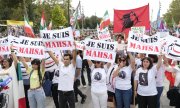Iran: crackdown a year after Mahsa Amini's death
On the anniversary of the death of the Iranian-Kurdish woman Mahsa Amini in police custody, which triggered a wave of protests, the Iranian regime is using force to crack down on new protests. Several people have been arrested for allegedly endangering public security and a state of emergency has been declared in Kurdish areas. Commentators discuss the chances of real change in the country.
Civil society will wait for its chance
The last twelve months have left their mark on Iran, Deník N believes:
“Even if, from a Western perspective, Iran has hardly changed or has even deepened its relations with other international authoritarian players, one must see the gradual changes taking place in its society and certain trends that accompany them. It is possible that the protests and commemorative rallies that take place this week and in the following weeks will not hurt its regime. At the same time, however, it is likely that such events and the experiences gained from them will create a stronger Iranian civil society that will consolidate and then wait for its chance.”
Regime and population are worlds apart
Le Monde also sees significant changes in Iranian society:
“The violence unleashed by the Iranian regime to suppress the protests has cost hundreds of lives and fulfilled its purpose. But at the same time it has drastically deepened the rift between the regime and its people. ... Iran's military-religious regime has turned its back on its population, which has little in common with what it was in the beginning. It has become larger, more urban and better educated - starting with the women. It is reforging itself in view of the waves of protest and oppression it has endured, and has good prospects for the future.”
The Iranians have had enough
Civil disobedience will undermine the regime in the long run, writes Die Presse:
“The security apparatus continues to stand firmly behind the ruling system. But Tehran cannot seriously have any illusions about its future prospects: for years, the intervals between demonstrations have been getting shorter and shorter and experts see a 'revolutionary process' underway in contemporary Iran. The country is in the middle of a revolution which must end with the regime's downfall. Whether this will happen tomorrow or in seven years' time is impossible to predict, of course. What can be said, however, is that the people have had enough.”
Slogans and banners won't bring change
Columnist Jawad Iqbal explains in The Spectator why the protest movement could well be doomed to failure:
“No one knows what the protesters specifically want for Iran. What are their shared political goals, assuming they have any? The initial mass demonstrations attracted huge numbers of young people, especially women, but no opposition can hope to succeed without a broader base of support across the population. Slogans and banners can never be enough in themselves. A political movement for change requires clarity of aims and purpose, otherwise this latest challenge to the regime risks fizzling out.”
The mullahs are not Iran
Politiken hopes that the people will defeat their oppressors:
“'Let us scatter flowers and put wine in the glass', wrote the 14th century Persian poet Hafez. His poetry is still cherished today ... Hafez was an Islamic poet, but from a different, far more tolerant time. A time when people in Iran also openly drank wine and wrote bawdy love poems. Hafez is a symbol of everything Iran was and could have become again. ... The mullahs are not representative of Iran. ... It's up to the Iranians to fight those in power, but those close by can and must do their best to help. ... In the long run, the regime will hopefully collapse under the pressure of the population.”

